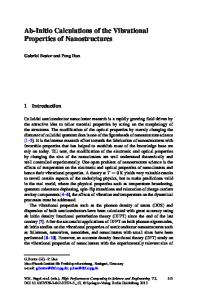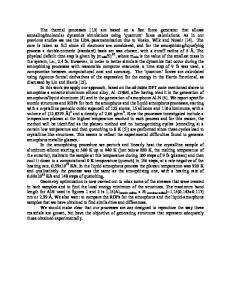An ab initio two-center tight-binding approach to simulations of complex materials properties
- PDF / 1,001,761 Bytes
- 14 Pages / 420.48 x 639 pts Page_size
- 6 Downloads / 376 Views
Within the framework of standard empirical TB theory, several proposals have been made co generalize the TB-energies by explicitly considering interatomic electron interactions within a standard Hubbard approach [12, 13, 14, 15]. Skriver and Rosengaard use an efficient selfconsistent Green's-function technique based on the LMTO-method within the tight-binding and atomicsphere approximation [16]. Tsai et al. [17] improved the ab initio multicenter TB scheme [5] in order to account for charge transfer. By using the Ewald technique, they added and subtracted to each atom a Gaussian charge distribution and solved the Schrfdinger equation iteratively, to determine the selfconsistent atomic charges. Demkov et al. [18] used a different approach to modify this TB scheme by including long ranged Hartree contributions, which leads to a selfconsistent adjustment of site-dependent occupation numbers. Here, we focus on a systematic extension of the tight-binding formalism and of our DF-TB scheme [3, 11] in order to derive a generalized selfconsistent charge (SCC) methodology. This differs from previous approaches since we base the modification of the TB total energy expression on a second-order expansion of the Kohn-Sham energy functional [19] with respect to density
fluctuations. The new methodology ensures a proper distribution of the charge and overcomes the requirement of local charge neutrality [4], especially in multi-component systems. In maintaining the simple two-center picture, the new scheme can be easily incorporated into any standard TBmethod. We demonstrate the improvements considering properties of molecular systems, where the non-SCC scheme failed, and point out recent successful applications to polar semiconductors. II. DENSITY-FUNCTIONAL BASED TIGHT-BINDING, DF-TB The total energy of a system of M electrons in the field of N nuclei at positions R may be written within DFT as a functional of a charge density n(?'):
E =: oce (:O i - AX 2+ V,ý,+ •jf
. 71@ }+ E .•nF) c •)+
I n'(F')
1~i
Z111Zo
,- 1-E
(1)
where the first sum is over occupied Kohn-Sham eigenstates Ti, the second term is the exchangecorrelation (XC) contribution, and the last term covers the ion-ion core repulsion, Eii. We now rewrite the total energy in order to transform the leading matrix elements. We first substitute the charge density in (1) by a superposition of a reference or input density n, = no(F') and a small fluctuation Sn' = Sn(i;"), fd•"' is expressed by f': oc•
f
n'o
E = E(Ti•l - - + V=,t + j •-•1+ Vc[no~ll'•) - 1f-J f v •[no](no + 6n) + 1
Jf
n(no + 6n) n'
•
'
+'n - + E.0 [no + 6n] + Eii.
(2)
The second term in this equation corrects for the double-counting of the new Hartree, the third term for the new XC contribution in the leading matrix element and the fourth term comes from dividing the full Hartree energy in (1) into a part related to no and to Sn. Finally, we expand Ec at the reference density and obtain the total energy correct to second order in the density fluctuations. Note that the terms linear in 6n cance
Data Loading...








